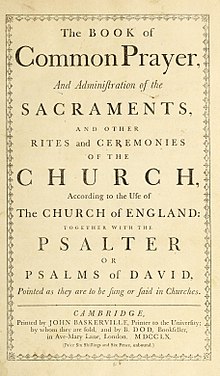
Back كتاب الصلوات Arabic Llibre de l'oració comuna Catalan Kniha společných modliteb Czech Llyfr Gweddi Gyffredin Welsh Book of Common Prayer Danish Book of Common Prayer German Book of Common Prayer Esperanto Libro de Oración Común Spanish کتاب نمازنامه عام Persian Book of Common Prayer Finnish

| Part of a series on |
| Anglicanism |
|---|
 |
|
|
The Book of Common Prayer (BCP) is the name given to a number of related prayer books used in the Anglican Communion and by other Christian churches historically related to Anglicanism. The first prayer book, published in 1549 in the reign of King Edward VI of England, was a product of the English Reformation following the break with Rome. The 1549 work was the first prayer book to include the complete forms of service for daily and Sunday worship in English. It contains Morning Prayer, Evening Prayer, the Litany, Holy Communion, and occasional services in full: the orders for Baptism, Confirmation, Marriage, "prayers to be said with the sick", and a funeral service. It also sets out in full the "propers" (the parts of the service that vary weekly or daily throughout the Church's Year): the introits, collects, and epistle and gospel readings for the Sunday service of Holy Communion. Old Testament and New Testament readings for daily prayer are specified in tabular format, as are the Psalms and canticles, mostly biblical, to be said or sung between the readings.[1]
The 1549 book was soon succeeded by a 1552 revision that was more Reformed but from the same editorial hand, that of Thomas Cranmer, Archbishop of Canterbury. It was used only for a few months, as after Edward VI's death in 1553, his half-sister Mary I restored Roman Catholic worship. Mary died in 1558 and, in 1559, Elizabeth I's first Parliament authorised the 1559 prayer book, which effectively reintroduced the 1552 book with modifications to make it acceptable to more traditionally minded worshippers and clergy.
In 1604, James I ordered some further changes, the most significant being the addition to the Catechism of a section on the Sacraments; this resulted in the 1604 Book of Common Prayer. Following the tumultuous events surrounding the English Civil War, when the Prayer Book was again abolished, another revision was published as the 1662 prayer book.[2] That edition remains the official prayer book of the Church of England, although throughout the later 20th century, alternative forms that were technically supplements largely displaced the Book of Common Prayer for the main Sunday worship of most English parish churches.
Various permutations of the Book of Common Prayer with local variations are used in churches within and exterior to the Anglican Communion in over 50 countries and over 150 different languages.[3] In many of these churches, the 1662 prayer book remains authoritative even if other books or patterns have replaced it in regular worship.
Traditional English-language Lutheran, Methodist, and Presbyterian prayer books have borrowed from the Book of Common Prayer, and the marriage and burial rites have found their way into those of other denominations and into the English language. Like the King James Version of the Bible and the works of Shakespeare, many words and phrases from the Book of Common Prayer have entered common parlance.
- ^ Careless 2003, p. 26.
- ^ Church of England 1662.
- ^ Careless 2003, p. 23.